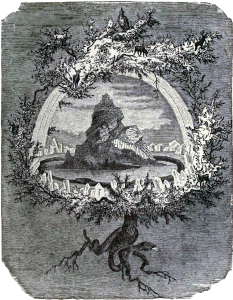The Dangerous Duality of Modern Paganism in America

America is a diverse place. Freedom of religion is taken seriously and has led to the world’s most interesting mix of highly individualized belief systems. This is no surprise considering the first migrants to arrive in North America fled religious persecution in their homeland and wished to build new lives for themselves where they could worship whatever god or variation of a god they wanted. America is a place where people are allowed to believe whatever they want to believe, and there are quite literally people who believe in anything and everything—from Bigfoot to Aliens to whatever you can think of, evidence not required.
It should therefore be of no surprise that there are small communities and individuals throughout the country who are reviving the old ways of Norse Paganism. Specifically, these groups of people want to emulate the belief systems of Viking Age Scandinavia. This belief system today goes by a few different names, Asatru being the most well known and accepted. Here I will refer to it as the Modern Pagan movement because of the numerous names that are derived from it. It is a subject near and dear to my heart because of the years I’ve spent devoted to the study of Scandinavian history. The attempt to revive their pagan ways is intrinsically interesting to me. Iceland, for example, is also experiencing a revival of what they call the “old ways” and their new pagan church has made headlines around the world. In an age where the masses are becoming disenfranchised with traditional institutions, this revival is attracting a great deal of attention.
There is much to applaud in this movement. It has ignited interest in history, in the exploration of a distant and foreign culture, and it has encouraged many to find a different path for personal growth. Yet what is most curious about this movement is how different the interpretations of the “old ways” seem to be. There is no consistency in Modern Paganism, but many (and I’ve met a few personally) are militant in how they defend their own particular brand of it. In fact, much of the zealousness demonstrated by mainstream religions has carried over, and there are those who are practicing this new faith with immovable conviction without basis in tradition or dogma. These people have an idealized, almost nostalgic vision of how life used to be in pre-Christian times, but it’s all wrong.
What must be noted is that we know very little of the pre-Christian pagan faiths of Northern Europe. What has survived to today isn’t from tradition but from testimonies written by Christian clerics who examined those religions through a specific cultural lens. After the Christianization of Scandinavia, the pagan traditions were essentially wiped out. Therefore, it is important to understand that, realistically, we know close to nothing about the details surrounding the religion of pre-Christian Scandinavia, and we can never truly know. With this in mind, the Modern Pagan movement begins to take on a more problematic character. It means that most of the practices and beliefs of Modern Pagans are mostly made up. This is a problem because the movement is being used by some for nefarious purposes.
The Modern Pagan movement has a seedy underbelly that is by no means representative of the larger population of believers—but it’s there. It seems that many who would seek to argue for their supremacy over others by virtue of race and heritage have hijacked the Modern Pagan movement and given it a bad name. Because there is no rigid doctrine to refer to, it is difficult to dispel their assertions or to convince those not affiliated with Modern Paganism that such views are incompatible with the faith. No one can say that the Vikings were not racist. We cannot know. So, the presumption will always be that Pagans are racist. To quote the Havamal, “The good is ignored where there is fault.”
On the one hand, there are people who are experiencing tremendous personal growth through the Modern Pagan movement. On the other hand, there are those who are utilizing it for hate. So while it all seems like fun and games, there is an innate danger in the revival of a religion that is mostly fictionalized and is derived from a fixation on heritage. Modern Paganism has left itself open to being hijacked and there really is no defense. If an established religion such as Christianity or Islam cannot weed out radicals, how can a revived religion with no clear structure be immune? Perhaps it is best if we not fool ourselves and stick to the history books. Of course, it’s a free country, so believe what you want. Just remember that free speech doesn’t protect hate.





